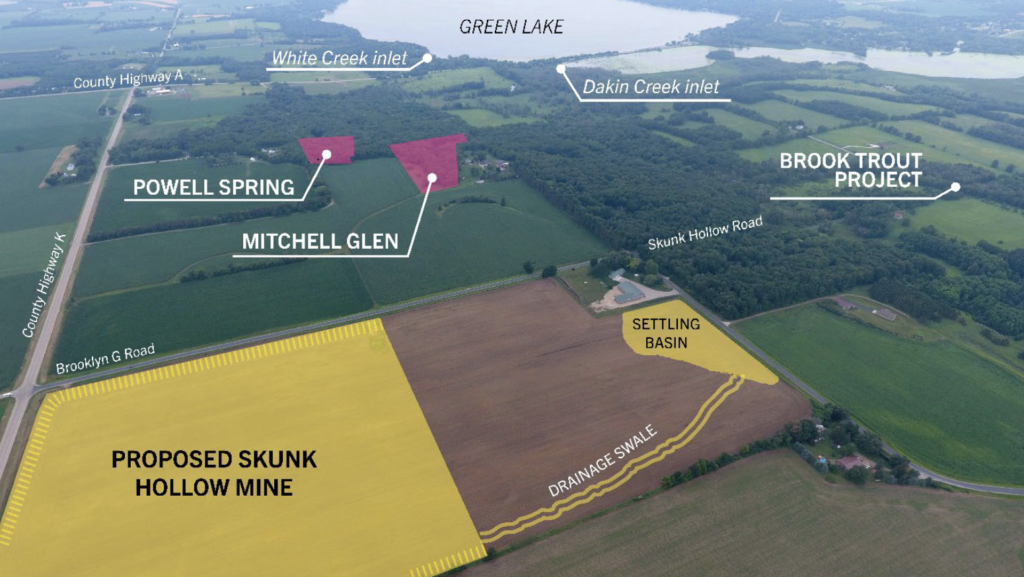By: Kristen Rasmussen – Director of Communication, GLA
GREEN LAKE, WISCONSIN, DECEMBER 12, 2022— The Green Lake County Board of Adjustment (BOA) will conduct a new hearing of the Kopplin & Kinas Skunk Hollow Mine on December 22, 2022 at 9:30 am. Three local entities—the Green Lake Association (GLA), the Green Lake Conservancy (GLC), and the Green Lake Sanitary District (GLSD)—are joining forces with a local landowner to appeal a conditional use permit (CUP) issued for Skunk Hollow Mine by the Green Lake County Land Use Planning and Zoning Committee.
The new hearing will determine whether to approve or deny a CUP for Skunk Hollow Mine, a proposed non-metallic mine at the intersection of County Road K and Brooklyn G Road. The hearing will be held at the Green Lake County Government Center and will allow for the introduction of expert studies, new evidence, and three minutes of public comment per person.
The three entities urge all who are able, either in person or virtually, to attend the December 22 hearing—as a strong showing will send an impactful signal to the BOA and Green Lake County about the importance of this landmark appeal to protect local natural resources.
If the approved plans move forward, the 40-acre quarry would be located just one field away from several iconic springs that are sensitive to groundwater fluctuations and would abut a neighborhood that relies on clean drinking water wells.
A hydrogeology study sponsored by the appellants concludes that: “Skunk Hollow Mine cannot be operated as proposed without adverse impacts on the health and welfare of nearby residents or without degradation of aquatic resources including Powell Spring and Creek, White Creek, Mitchell Glen, Glen Creek, and Dakin Creek.”
These unique resources near the proposed Skunk Hollow Mine are tens of thousands of years old. The community and local government are responsible for protecting these ecological treasures to avoid risking irreversible damage to Green Lake’s waterways.
The hydrogeology study also states: “The CUP application materials lack important information needed to provide confidence that the public health and the environment can be protected with the mine in operation.”
Carl Nehm, a dairy farmer adjacent to the potential quarry, depends on a reliable supply of potable water for his operation. Any compromises to his well—the farm’s only water source—would require trucking in water for his cows, an economically unsustainable option.
“The farm is approximately 300 acres and we’ve been on this location since 1990,” shared Nehm. “A quarry at this location could have substantial disruption to our dairy operation.”
An appraisal study commissioned for the Neuenfeldts—a neighbor who is part of the appeal and whose property abuts a stormwater pond from the proposed mine—found market value damages to their property of $324,500, if the mine is permitted. The cumulative negative impact to residents’ properties within 1/2-mile of the proposed mine and to the County’s tax base would total $909,500.
The Green Lake County Land Use Planning & Zoning Committee public hearing in July was packed with community members who expressed concern over the lack of public notice and insufficient consideration of ecological risks of the proposed project. After hours of public comment and testimony, committee members approved a CUP for Skunk Hollow Mine.
Since then, members of the surrounding community—separate from the three organizations who filed the appeal—have come together to form a coalition called “Stop the Mine. Save Green Lake.” to prevent the mine from going forward.
One resident, Mat Boerson, expressed frustration that the public outcry has largely gone unnoticed by governmental officials and committee members tasked with protecting the public.
“If this proposed mine is supposedly so good for the community, then why are so many people sad, angry, and frustrated by Kopplin & Kinas?” questioned Boerson, a local farmer whose children and wife grew up exploring Mitchell Glen, a nearby sandstone gorge with a 40-foot waterfall and a microclimate that sustains unique flora and fauna for the region.
“To survive in farming, we need to respect the land and the water,” said Nehm. “Commencing a mining operation so incredibly close to this treasure of Mitchell Glen seems short-sighted.”
The GLA, GLC, and GLSD remain committed to protecting the natural resources under threat due to their proximity to the mine, including nearby unique waterways like Mitchell Glen, Green Lake’s two primary trout streams, and Powell Spring—all of which flow directly into Big Green Lake.
“We are not opposed to mining, but we are concerned about mining here,” said Stephanie Prellwitz, Executive Director of the GLA, on behalf of the appellants. “Our organizations have been working tirelessly to protect these natural resources. We cannot sacrifice short-term gains for potential permanent damage to our tremendous ecological assets.”
On behalf of its water resources, ecological treasures, and the community, the three organizations urge the community to attend the BOA hearing on December 22 at 9:30 am. Those who are not able to attend in person or virtually can submit written comments by December 20 to BOA Secretary Karen Werlein, emailed to [email protected] or mailed to 571 County Road A, Attention: Board of Adjustment. Visit greenlakeassociation.org/skunk-hollow-mine for details.

Photo Credit: Mat and Henry Boerson; graphics by the Green Lake Association.
